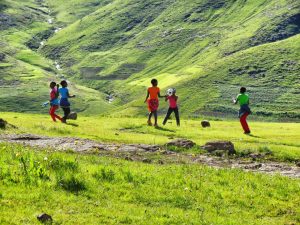This project is made possible through the partnership of Water Charity and the National Peace Corps Association. ![]()
Location
Sefateng, Lesobeng, Thaba Tseka, Lesotho
Community Description
Sefateng (the place of the tree) is a chieftainship of 75 families. Sefateng is a sustenance farming and herding community. Harvest is from March to June, and at the end of each harvest day, everyone eats fresh peaches, peas, and mustard greens, while sitting on the ground on blankets cleaning the last of the previous year’s barley.
Almost every Saturday everyone gets together for a community meeting to discuss water conservation, herding patterns, or plowing regulations with the village chief. Afterward, the cattle theft neighborhood watch will break off for a separate meeting focused on sheep selling rules, and effective punishment methods for those unfortunate cattle thieves who happen to be caught in the act.
Secondary school fees are commonly paid in sheep, as the price of one sheep is equal to one year of sending your child to school. Girls spend the weekends collecting firewood–since everybody in the village cooks on an open fire–and picking wild greens, while the boys herd sheep all day in the surrounding mountains. Many boys opt out of school to live in the mountains, continuously herding until they earn enough cattle to pay the bride price. Then they marry and hire their own herd boys.
After the work is done, people sing and dance. All the women from the village get together at 5 pm for cultural dance, and the men frequently dance outside the shop, which is not always a sober dance.
Problem Addressed
There is currently one latrine in the area, and public defecation is regularly practiced.
The Sefateng community lacks latrines and has wanted latrines for many years. They started to dig holes and collect stones for a project three years ago, but they lacked the funds to complete the project. When Martha, the Peace Corps Volunteer, explained the possibility of project funding, they immediately started to put together a plan. The latrine project addresses many community needs. The lack of latrines and hence regular open defecation, has resulted in polluting the community’s water source and has also contributed to the spread of fecal-oral diseases. The community is also fed up with the inconveniences of not having easily accessible latrines, as is common in much of Lesotho.
Project Description
This project is to build latrines for 39 families in a mountainous community in rural Lesotho.
The holes are to be two meters deep and one meter across on each side. The dimensions were chosen in accordance with the holes in a neighboring village. The buildings are to be of corrugated iron and about 6 feet high and 3 feet across on each side, the standard size in the area. The structures will be bought from a shop for about two hours from the village. They are sold in a package, which includes the frame, ventilation pipe, iron, and seat for one latrine.
The goal of this project is to:
1) provide access to pit latrines that will improve quality of life, and
2) eliminate public defecation, thereby reducing the transmission of fecal-oral disease and improving land and water sanitation.
 Water Charity funds will be used to pay for necessary materials and latrine construction.
Water Charity funds will be used to pay for necessary materials and latrine construction.
Each of the 39 families involved in the project has made a 100 Maluti contribution. Each family is also responsible for digging a hole, collecting sand, and collecting stones for their own latrine.
Many of the families have already started digging holes. Only a few families are still digging. The project committee has been accountable for making sure each family completes their part on time, as each family is responsible for the hole, sand, and stones for their own future latrine. After the community finishes their portion of the manual labor, the necessary materials for the project will be purchased, and contract laborers hired to construct the latrines.
It is anticipated that the construction of all of the latrines will be completed in four months. The latrine committee is committed to making sure the latrines are built in a timely manner.
The digging of the holes is almost complete, and the villagers are waiting for a good rain so sand and stones can be easily collected. There is a lack of water in the village currently, which makes laying the cement hard at this time. Contractors will be hired to build the structures once the holes are dug, sand and stones are collected, and the materials and cement have been purchased.
Project Impact
This project will benefit about 300 people.
Peace Corps Volunteer Directing Project
Martha Wagley
Monitoring and Maintenance
After the latrines are constructed, the community will organize a session with the local clinic to teach proper latrine use and maintenance. The community will be responsible for monitoring and maintenance, with the PCV ensuring follow-through by the community.
Comments
Currently, the community defecates on the land surrounding the river, which is the main water source in the area. The river is used for washing clothes, bathing, and drinking water. In addition, the river is a long trek from the homes of many community members. Hence, the project will improve land and water sanitation, reduce the spread of fecal-oral transmitted diseases, and eliminate the inconveniences presented by the lack of latrines.
Dollar Amount of Project
$3,400
Donations Collected to Date
$0
Dollar Amount Needed
$3,400
This project has been completed. To read about the conclusion, CLICK HERE.
ADOPT THIS PROJECT BY CONTRIBUTING THE DOLLAR AMOUNT OF THE PROJECT.
Donations of any amount will be appreciated. The full amount will allow you a posted dedication if that is something you would like.